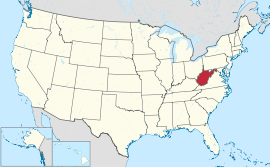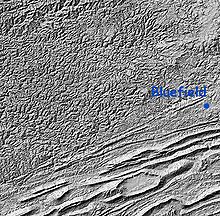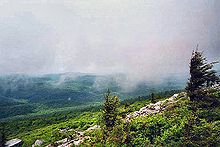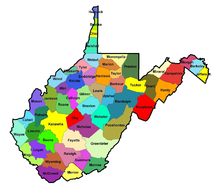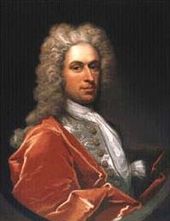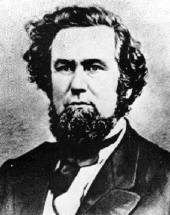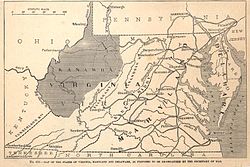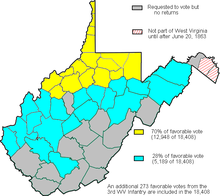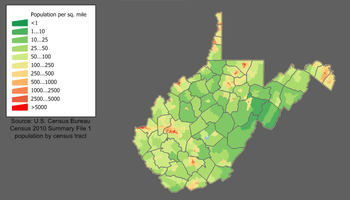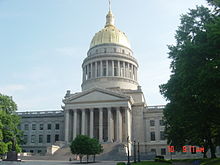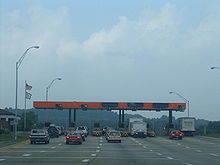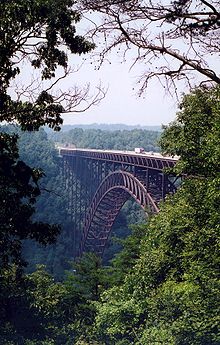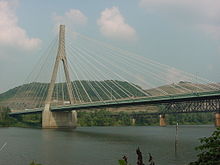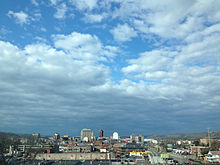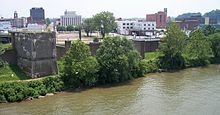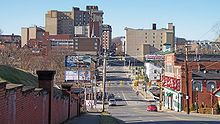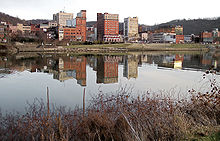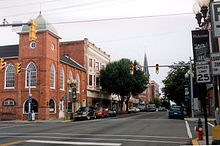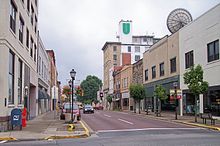
West Virginia
Background to the schools Wikipedia
The articles in this Schools selection have been arranged by curriculum topic thanks to SOS Children volunteers. To compare sponsorship charities this is the best sponsorship link.
| State of West Virginia | |||||
|
|||||
| Nickname(s): Mountain State | |||||
| Motto(s): Montani semper liberi (English: Mountaineers Are Always Free) |
|||||
| Official language(s) | none (de facto English) | ||||
| Demonym | West Virginian | ||||
| Capital ( and largest city) |
Charleston | ||||
| Largest metro area | Charleston metro area | ||||
| Area | Ranked 41st in the U.S. | ||||
| - Total | 24,230 sq mi (62,755 km2) |
||||
| - Width | 130 miles (210 km) | ||||
| - Length | 240 miles (385 km) | ||||
| - % water | 0.6 | ||||
| - Latitude | 37° 12′ N to 40° 39′ N | ||||
| - Longitude | 77° 43′ W to 82° 39′ W | ||||
| Population | Ranked 38th in the U.S. | ||||
| - Total | 1,855,413 (2012 est) | ||||
| - Density | 77.1/sq mi (29.8/km2) Ranked 29th in the U.S. |
||||
| - Median household income | $38,029 (48th) | ||||
| Elevation | |||||
| - Highest point | Spruce Knob 4863 ft (1482 m) |
||||
| - Mean | 1,500 ft (460 m) | ||||
| - Lowest point | Potomac River at Virginia border 240 ft (73 m) |
||||
| Before statehood | Virginia | ||||
| Admission to Union | June 20, 1863 (35th) | ||||
| Governor | Earl Ray Tomblin (D) | ||||
| Lieutenant Governor | Jeff Kessler (D) | ||||
| Legislature | West Virginia Legislature | ||||
| - Upper house | Senate | ||||
| - Lower house | House of Delegates | ||||
| U.S. Senators | Jay Rockefeller (D) Joe Manchin (D) |
||||
| U.S. House delegation | 1: David McKinley (R) 2: Shelley Moore Capito (R) 3: Nick Rahall (D) ( list) |
||||
| Time zone | Eastern: UTC -5/ -4 | ||||
| Abbreviations | WV US-WV | ||||
| Website | wv.gov | ||||
West Virginia ( / ˌ w ɛ s t v ər ˈ dʒ ɪ n j ə /) is a U.S. state located in the Appalachian region of the Southern United States. It is bordered by Virginia to the southeast, Kentucky to the southwest, Ohio to the northwest, Pennsylvania to the north, and Maryland to the northeast. West Virginia is the 41st largest by area and the 38th most populous of the 50 United States. The capital and largest city is Charleston.
West Virginia became a state following the Wheeling Conventions and broke away from Virginia during the American Civil War. The new state was admitted to the Union on June 20, 1863, and was a key Civil War border state. West Virginia was the only state to form by seceding from a Confederate state and was one of two states formed during the American Civil War (the other one being Nevada, which separated from Utah Territory).
The Census Bureau and the Association of American Geographers classify West Virginia as part of the South. The northern panhandle extends adjacent to Pennsylvania and Ohio, with the West Virginia cities of Wheeling and Weirton just across the border from the Pittsburgh metropolitan area, while Bluefield is less than 70 miles (110 km) from North Carolina. Huntington in the southwest is close to the states of Ohio and Kentucky, while Martinsburg and Harpers Ferry in the Eastern Panhandle region are considered to be a part of the Washington metropolitan area, in between the states of Maryland and Virginia. The unique position of West Virginia means that it is often included in several geographical regions, including the Mid-Atlantic, the Upland South, and the Southeastern United States. It is the only state that is entirely within the area served by the Appalachian Regional Commission; the area is commonly defined as " Appalachia."
The state is noted for its mountains and diverse topography, its historically significant logging and coal mining industries, and its political and labor history. It is one of the most densely karstic areas in the world, making it a choice area for recreational caving and scientific research. The karst lands contribute to much of the state's cool trout waters. It is also known for a wide range of outdoor recreational opportunities, including skiing, whitewater rafting, fishing, hiking, backpacking, mountain biking and hunting.
Geography
Located in the Appalachian Mountain range, West Virginia covers an area of 24,229.76 square miles (62,754.8 km2), with 24,077.73 square miles (62,361.0 km2) of land and 152.03 square miles (393.8 km2) of water, making it the 41st-largest state in the United States. West Virginia borders Pennsylvania and Maryland in the northeast, Virginia in the southeast, Ohio in the northwest, and Kentucky in the southwest. Its longest border is with Virginia at 381 miles, followed by Ohio at 243 miles, Maryland 174 miles, Pennsylvania 118 miles and Kentucky at 79 miles.
Geology and terrain
West Virginia is located entirely within the Appalachian Region, and the state is almost entirely mountainous, giving reason to the nickname The Mountain State and the motto Montani Semper Liberi ("Mountaineers are always free"). The elevations and ruggedness drop near large rivers like the Ohio River or Shenandoah River. About 75% of the state is within the Cumberland Plateau and Allegheny Plateau regions. Though the relief is not high, the plateau region is extremely rugged in most areas. The average elevation of West Virginia is approximately 1,500 feet (460 m) above sea level, which is the highest of any US state east of the Mississippi River.
On the eastern state line with Virginia, high peaks in the Monongahela National Forest region give rise to an island of colder climate and ecosystems similar to those of northern New England and eastern Canada. The highest point in the state is atop Spruce Knob, at 4,863 ft (1,482 m), and is covered in a boreal forest of dense spruce trees at altitudes above 4,000 feet (1,200 m). Spruce Knob lies within the Monongahela National Forest and is a part of the Spruce Knob-Seneca Rocks National Recreation Area. A total of six wilderness areas can also be found within the forest. Outside the forest to the south, the New River Gorge is a canyon 1,000 feet (300 m) deep, carved by the New River. The National Park Service manages a portion of the gorge and river that has been designated as the New River Gorge National River, one of only 15 rivers in the U.S. with this level of protection.
Other areas under protection and management include:
|
|
Most of West Virginia lies within the Appalachian mixed mesophytic forests ecoregion, while the higher elevations along the eastern border and in the panhandle lie within the Appalachian-Blue Ridge forests. The native vegetation for most of the state was originally mixed hardwood forest of oak, chestnut, maple, beech, and white pine, with willow and American sycamore along the state's waterways. Many of the areas are rich in biodiversity and scenic beauty, a fact that is appreciated by native West Virginians, who refer to their home as Almost Heaven (from the song, " Take Me Home, Country Roads" by John Denver). Before the song, it was known as "The Cog State" (Coal, Oil, and Gas) or "The Mountain State."
The underlying rock strata are sandstone, shale, bituminous coal beds, and limestone laid down in a near-shore environment from sediments derived from mountains to the east, in a shallow inland sea on the west. Some beds illustrate a coastal swamp environment, some river delta, some shallow water. Sea level rose and fell many times during the Mississippian and Pennsylvanian eras, giving a variety of rock strata. The Appalachian Mountains are some of the oldest on earth, having formed over 300 million years ago.
Climate
| West Virginia state-wide averages | ||||||||||||||||||||||||||||||||||||||||||||||||||||||||||||
|---|---|---|---|---|---|---|---|---|---|---|---|---|---|---|---|---|---|---|---|---|---|---|---|---|---|---|---|---|---|---|---|---|---|---|---|---|---|---|---|---|---|---|---|---|---|---|---|---|---|---|---|---|---|---|---|---|---|---|---|---|
| Climate chart ( explanation) | ||||||||||||||||||||||||||||||||||||||||||||||||||||||||||||
|
||||||||||||||||||||||||||||||||||||||||||||||||||||||||||||
|
||||||||||||||||||||||||||||||||||||||||||||||||||||||||||||
The climate of West Virginia is a humid subtropical climate ( Köppen climate classification Cfa) in some of the lower elevations, primarily in the southwestern portion of the state (including Huntington and Charleston), along with parts of the Eastern Panhandle east of the Appalachians with hot, humid summers and milder winters. The rest of the state generally has a humid continental climate ( Köppen climate classification Dfa, except Dfb at the higher elevations) with warm to hot, humid summers and cool to cold winters, increasing in severity with elevation. Some southern highland areas also have a mountain temperate climate (Köppen Cfb) where winter temperatures are more moderate and summer temperatures are somewhat cooler. However, the weather is subject in all parts of the state to change. The hardiness zones range from zone 5b in the central Appalachian mountains to zone 7a in the warmest parts of the lowest elevations. In the Eastern Panhandle and the Ohio River Valley, temperatures are warm enough to see and grow subtropical plants such as Southern magnolia ( Magnolia grandiflora), Crepe Myrtle, Albizia julibrissin, American Sweetgum and even the occasional needle palm and sabal minor. These plants do not thrive as well in other parts of the state. The Eastern prickly pear grows well in many portions of the state.
Average January temperatures range from around 26 °F (−4 °C) near the Cheat River to 41 °F (5 °C) along sections of the border with Kentucky. July averages range from 67 °F (19 °C) along the North Branch Potomac River to 76 °F (24 °C) in the western part of the state. It is cooler in the mountains than in the lower sections of the state. The highest recorded temperature in the state is 112 °F (44 °C) at Martinsburg on July 10, 1936 and the lowest recorded temperature in the state is −37 °F (−38 °C) at Lewisburg on December 30, 1917.
Annual precipitation ranges from less than 32 inches (81 cm) in the lower eastern section to more than 56 inches (140 cm) in higher parts of the Allegheny Front. Slightly more than half the rainfall occurs from April to September. Dense fogs are common in many valleys of the Kanawha section, especially the Tygart Valley. West Virginia is also one of the cloudiest states in the nation, with the cities of Elkins and Beckley ranking 9th and 10th in the U.S. respectively for the number of cloudy days per year (over 210). In addition to persistent cloudy skies caused by the damming of moisture by the Alleghenies, West Virginia also experiences some of the most frequent precipitation in the nation, with Snowshoe averaging nearly 200 days a year with either rain or snow. Snow usually lasts only a few days in the lower sections but may persist for weeks in the higher mountain areas. An average of 34 inches (86 cm) of snow falls annually in Charleston, although during the winter of 1995–1996 more than three times that amount fell as several cities in the state established new records for snowfall. Average snowfall in the Allegheny Highlands can range up to 180 inches (460 cm) per year. Severe weather is somewhat less prevalent in West Virginia than in most other eastern states, and it ranks among the least tornado-prone states east of the Rockies.
History
Many ancient man-made earthen mounds from various prehistoric mound builder cultures survive, especially in the areas of Moundsville, South Charleston, and Romney. The artifacts uncovered in these give evidence of a village societies. They had a tribal trade system culture that crafted cold worked copper pieces.
The Iroquois drove out other Native American tribes from the area to reserve the upper Ohio Valley as a hunting ground after the Beaver Wars further east. Other indigenous tribes had occupied the area before them: the Osage and other Siouan-language tribes migrated west across the Mississippi River to escape the warfare.
The area now occupied by West Virginia was contested territory among European Americans as well, with the colonies of Pennsylvania and Virginia claiming territorial rights before the American Revolutionary War. Some speculative land companies, such as the Vandalia Company, and later the Ohio Company and Indiana Company, tried to legitimize their claims to land in parts of West Virginia and Kentucky, but failed. With the settlement of the Pennsylvania and Virginia border dispute, which resulted in the creation of Kentucky, Kentuckians "were satisfied [...], and the inhabitants of a large part of West Virginia were grateful."
West Virginia was originally part of the British Virginia Colony (from 1607 to 1776) and the western part of the state of Virginia (from 1776 to 1863). Long discontented with electoral malapportionment and underrepresentation in the state legislature, its residents became sharply divided over the issue of secession from the Union. Residents of western and northern counties set up a separate government under Francis Pierpont in 1861, which they called the "restored" government. Most voted to separate from Virginia, and the new state was admitted to the Union in 1863. In 1864 a state constitutional convention drafted a constitution, which was ratified by the legislature without putting it to popular vote. West Virginia abolished slavery and temporarily disfranchised men who had held Confederate office or fought for the Confederacy.
West Virginia's history has been profoundly affected by its mountainous terrain, numerous and vast river valleys, and rich natural resources. These were all factors driving its economy and the lifestyles of residents, and remain so today.
Prehistory
A 2010 analysis of a local stalagmite revealed that native Americans were burning forests to clear land as early as 100 BC. Some regional late-prehistoric Eastern Woodland tribes were more involved in hunting and fishing, practicing the slash and burn Eastern Agricultural Complex gardening method. Another group progressed to the more time-consuming, advanced companion crop fields method of gardening. Also continuing from ancient indigenous people of the state, field space and time was given to tobacco growing through to early historic.
"Maize (corn) did not make a substantial contribution to the diet until after 1150 B.P.", to quote Mills (OSU 2003). Eventually, tribal villages began relying heavily on corn to feed their turkey flocks, as Kanawha Fort Ancients practiced bird husbandry. The local Indians made corn bread and a flat rye bread called "banick" as they emerged from the protohistoric era. A horizon extending from a little before the early 18th century is sometimes called the acculturating Fireside Cabin culture, when trading posts along the Potomac and James rivers spread across the state.
Dr. Robert F. Maslowski wrote, "The Adena Indians used pipes for ceremonies. They were carved of stone and they were exceptional works of art. Pipes and the smoking of tobacco became more common during the Late Prehistoric period. They were often made of clay and rather plain." "Nothing is known about Paleo-Indian and Archaic houses in the Kanawha Valley, but archeologists have found evidence of Woodland and Fort Ancient houses." " Woodland Indians lived in wigwams ... The Woodland Indians grew sunflowers, gourds, squash and several seeds such as lambsquarter, may grass, sumpweed, smartweed and little barley." " Fort Ancient Indians lived in much larger square or rectangular houses ... The Fort Ancient Indians can be considered true farmers. They cultivated large agricultural fields around their villages. They no longer grew such a variety of seeds but concentrated on growing corn, beans, sunflowers, gourds, and many types of squash including the pumpkin. They also grew domestic turkeys and kept dogs as pets." As of 2009, over 12,500 archaeological sites have been documented in West Virginia (Bryan Ward 2009:10).
European exploration and settlement
In 1671, General Abraham Wood, at the direction of Royal Governor William Berkeley of the Virginia Colony, sent a party from Fort Henry led by Thomas Batts and Robert Fallam that discovered Kanawha Falls. In 1716, Governor Alexander Spotswood with about thirty horsemen made an excursion into what is now Pendleton County. John Van Metre, an Indian trader, penetrated into the northern portion in 1725. The same year, German settlers from Pennsylvania founded New Mecklenburg, the present Shepherdstown, on the Potomac River, and others followed.
King Charles II of England, in 1661, granted to a company of gentlemen the land between the Potomac and Rappahannock rivers, known as the Northern Neck. The grant finally came into the possession of Thomas Fairfax, 6th Lord Fairfax of Cameron, and in 1746, a stone was erected at the source of the North Branch Potomac River to mark the western limit of the grant. A considerable part of this land was surveyed by George Washington between 1748 and 1751. The diary kept by the surveyor indicates that there were already many squatters, largely of German origin, along the South Branch Potomac River. Christopher Gist, a surveyor in the employ of the first Ohio Company, which was composed chiefly of Virginians, explored the country along the Ohio River north of the mouth of the Kanawha River between 1751 and 1752. The company sought to have a fourteenth colony established with the name " Vandalia". Many settlers crossed the mountains after 1750, though they were hindered by Native American resistance. Few Native Americans lived permanently within the present limits of the state, but the region was a common hunting ground, crossed by many trails. During the French and Indian War the scattered British settlements were almost destroyed.
In 1774, the Crown Governor of Virginia John Murray, 4th Earl of Dunmore, led a force over the mountains, and a body of militia under then-Colonel Andrew Lewis dealt the Shawnee Indians, under Hokoleskwa (or "Cornstalk"), a crushing blow during the Battle of Point Pleasant at the junction of the Kanawha and the Ohio rivers. Native American attacks continued until after the American Revolutionary War. During the war, the settlers in western Virginia were generally active Whigs and many served in the Continental Army. However, Claypool's Rebellion of 1780–1781, in which a group of men refused to pay Colonial taxes showed war-weariness in West Virginia.
Trans-Allegheny Virginia
Social conditions in western Virginia were entirely unlike those in the eastern portion of the state. The population was not homogeneous, as a considerable part of the immigration came by way of Pennsylvania and included Germans, Protestant Scotch-Irish, and settlers from the states farther north. Counties in the east and south were settled mostly by east Virginians. During the American Revolution, the movement to create a state beyond the Alleghenies was revived and a petition for the establishment of " Westsylvania" was presented to Congress, on the grounds that the mountains made an almost impassable barrier on the east. The rugged nature of the country made slavery unprofitable, and time only increased the social, political, economic and cultural differences (see Tuckahoe-Cohee) between the two sections of Virginia.
The convention that met in 1829 to form a new constitution for Virginia, against the protest of the counties beyond the mountains, required a property qualification for suffrage and gave the slave-holding counties the benefit of three-fifths of their slave population in apportioning the state's representation in the U.S. House of Representatives. As a result, every county beyond the Alleghenies except one voted to reject the constitution, which nevertheless passed because of eastern support.
The Virginia Constitutional Convention of 1850–51, the Reform Convention, addressed a number of issues important to western Virginians. The vote was extended to all white males of 21 years of age plus. The governor, lieutenant-governor, the judiciary, sheriffs and other county officers were to be elected by public vote. The composition of the General Assembly was changed, representation in the house of delegates was apportioned on the white basis of the census of 1850, but the Senate was fixed arbitrarily, the west receiving twenty, and the east thirty, senators. This was made acceptable to the west by a provision that required the General Assembly to reapportion representation on the white basis in 1865, or else put the matter to a public referendum. But the east also gave itself a tax advantage in requiring a property tax at true and actual value, except for slaves. Slaves under the age of 12 years were not taxed, and slaves over that age were taxed at only $300, a fraction of their true value. Small farmers, however, had all their assets, animals and land, taxed at full value. Despite this tax and the lack of internal improvements in the west, the vote was 75,748 for and 11,063 against the new Constitution, most of the latter being from eastern counties, which did not like the compromises made for the west.
Given the differences, many in the west had long contemplated a separate state. In particular, men like the lawyer Francis H. Pierpont from Fairmont, had long chafed under the political domination of the Tidewater and Piedmont slave-holders. In addition to differences over the abolition of slavery, it was felt the Virginia government ignored and refused to spend funds on needed internal improvements in the west, such as turnpikes and railroads.
Separation from Virginia
West Virginia was the only state in the Union to secede from a Confederate state ( Virginia) during the American Civil War. In Richmond on April 17, 1861, the 49 delegates from the future state of West Virginia voted 17 in favour of the Ordinance of Secession (of Virginia from the United States), 30 against and 2 abstentions. Almost immediately after the vote to proceed with secession from the Union prevailed in the Virginia General Assembly, a mass meeting at Clarksburg recommended that each county in northwestern Virginia send delegates to a convention to meet in Wheeling on May 13, 1861. When this First Wheeling Convention met, 425 delegates from 25 counties were present, though more than one-third of the delegates were from the northern panhandle area, but soon there was a division of sentiment.
Some delegates favored the immediate formation of a new state, while others argued that, as Virginia's secession had not yet been passed by the required referendum, such action would constitute revolution against the United States. It was decided that if the ordinance were adopted (of which there was little doubt), another convention including the members-elect of the legislature should meet at Wheeling in June. At the election on May 23, 1861, secession was ratified by a large majority in the state as a whole, but in the western counties 34,677 voted against and 19,121 voted for the Ordinance.
The Second Wheeling Convention met as agreed on June 11 and declared that, since the Secession Convention had been called without the consent of the people, all its acts were void, and that all who adhered to it had vacated their offices. The Wheeling Conventions, and the delegates themselves, were never actually elected by public ballot to act on behalf of western Virginia. An act for the reorganization of the government was passed on June 19. The next day Francis H. Pierpont was chosen by other delegates at the convention to be governor of Virginia, other officers were elected and the convention adjourned. The legislature was composed of 103 members, 33 of whom had been elected to the Virginia General Assembly on May 23.
This number included some hold-over Senators from 1859, and as such had vacated their offices to convene in Wheeling. The other members "were chosen even more irregularly –some in mass meetings, others by county committee, and still others were seemingly self-appointed" This irregular assembly met on June 20 and appointed Unionists to hold the remainder of the state offices, organized a rival state government and elected two United States senators who were promptly recognized by the federal government in Washington, D.C. Thus, there were two state governments in Virginia, one pledging allegiance to the United States and one to the Confederacy.
The Wheeling Convention, which had taken a recess until August 6, reassembled on August 20, and called for a popular vote on the formation of a new state and for a convention to frame a constitution if the vote should be favorable. At the October 24, 1861 election, 18,408 votes were cast for the new state and only 781 against. The honesty of these election results has been questioned, since the Union army then occupied the area and Union troops were stationed at many of the polls to prevent Confederate sympathizers from voting. Most of the affirmative votes came from 16 counties around the Northern panhandle. Over 50,000 votes had been cast on the Ordinance of Secession, yet the vote on statehood gathered little more than 19,000.
In Ohio County, home to Wheeling, only about one-quarter of the registered voters cast votes. At the Constitutional Convention in November 1861, Mr. Lamb of Ohio County and Mr. Carskadon said that in Hampshire County, out of 195 votes only 39 were cast by citizens of the state; the rest were cast illegally by Union soldiers. In most of what would become West Virginia, there was no vote at all as two-thirds of the territory of West Virginia had voted for secession and county officers were still loyal to Richmond. Votes recorded from pro-secession counties were mostly cast elsewhere by Unionist refugees from these counties. The convention began on November 26, 1861, and finished its work on February 18, 1862; the instrument was ratified (18,162 for and 514 against) on April 11, 1862.

On May 13 the state legislature of the reorganized government approved the formation of the new state. An application for admission to the Union was made to Congress, and on December 31, 1862, an enabling act was approved by President Abraham Lincoln admitting West Virginia, on the condition that a provision for the gradual abolition of slavery be inserted in its constitution. While many felt that West Virginia's admission as a state was both illegal and unconstitutional, Lincoln issued his Opinion on the Admission of West Virginia finding that "the body which consents to the admission of West Virginia, is the Legislature of Virginia," and that its admission was therefore both constitutional and expedient.
The convention was reconvened on February 12, 1863, and the demand was met. The revised constitution was adopted on March 26, 1863, and on April 20, 1863, President Lincoln issued a proclamation admitting the state at the end of 60 days (June 20, 1863). Meanwhile, officers for the new state were chosen and Gov. Pierpont moved his capital to Union-occupied Alexandria, where he asserted jurisdiction over all of the Virginia counties within the federal lines.
The question of the constitutionality of the formation of the new state was brought before the Supreme Court of the United States in the following manner: Berkeley and Jefferson counties lying on the Potomac east of the mountains, in 1863, with the consent of the reorganized government of Virginia voted in favour of annexation to West Virginia. Many voters of the strongly pro-secessionist counties were absent in the Confederate Army when the vote was taken and refused to acknowledge the transfer upon their return. The Virginia General Assembly repealed the act of secession and in 1866 brought suit against West Virginia, asking the court to declare the counties a part of Virginia which would have declared West Virginia's admission as a state unconstitutional. Meanwhile, on March 10, 1866, Congress passed a joint resolution recognizing the transfer. The Supreme Court, in 1870, decided in favour of West Virginia.
During the American Civil War, West Virginia suffered comparatively little. Union General George B. McClellan's forces gained possession of the greater part of the territory in the summer of 1861, culminating at the Battle of Rich Mountain, and Union control was never again seriously threatened, despite an attempt by Robert E. Lee in the same year. In 1863, General John D. Imboden, with 5,000 Confederates, overran a considerable portion of the state. Bands of guerrillas burned and plundered in some sections, and were not entirely suppressed until after the war ended. The Eastern Panhandle counties were more affected by the war, with military control of the area repeatedly changing hands.
The area which became West Virginia actually furnished about an equal number of soldiers to the federal and Confederate armies, approximately 22,000–25,000 each. The Wheeling government found it necessary in 1865 to strip voting rights from returning Confederates in order to retain control. James Ferguson, who proposed the law, said that if it was not enacted he would lose election by 500 votes. The property of Confederates might also be confiscated, and in 1866 a constitutional amendment disfranchising all who had given aid and comfort to the Confederacy was adopted. The addition of the Fourteenth and Fifteenth Amendments to the United States Constitution caused a reaction. The Democratic party secured control in 1870, and in 1871, the constitutional amendment of 1866 was abrogated. The first steps toward this change had been taken, however, by the Republicans in 1870. On August 22, 1872, an entirely new constitution was adopted.
Beginning in Reconstruction, and for several decades thereafter, the two states disputed the new state's share of the pre-war Virginia government's debts, which had mostly been incurred to finance public infrastructure improvements, such as canals, roads, and railroads under the Virginia Board of Public Works. Virginians, led by former Confederate General William Mahone, formed a political coalition which was based upon this, the Readjuster Party. Although West Virginia's first constitution provided for the assumption of a part of the Virginia debt, negotiations opened by Virginia in 1870 were fruitless, and in 1871, Virginia funded two-thirds of the debt and arbitrarily assigned the remainder to West Virginia. The issue was finally settled in 1915, when the Supreme Court of the United States ruled that West Virginia owed Virginia $12,393,929.50. The final installment of this sum was paid in 1939.
Demographics
| Historical populations | |||
|---|---|---|---|
| Census | Pop. | %± | |
| 1790 | 55,873 |
|
|
| 1800 | 78,592 | 40.7% | |
| 1810 | 105,469 | 34.2% | |
| 1820 | 136,808 | 29.7% | |
| 1830 | 176,924 | 29.3% | |
| 1840 | 224,537 | 26.9% | |
| 1850 | 302,313 | 34.6% | |
| 1860 | 376,688 | 24.6% | |
| 1870 | 442,014 | 17.3% | |
| 1880 | 618,457 | 39.9% | |
| 1890 | 762,794 | 23.3% | |
| 1900 | 958,800 | 25.7% | |
| 1910 | 1,221,119 | 27.4% | |
| 1920 | 1,463,701 | 19.9% | |
| 1930 | 1,729,205 | 18.1% | |
| 1940 | 1,901,974 | 10.0% | |
| 1950 | 2,005,552 | 5.4% | |
| 1960 | 1,860,421 | −7.2% | |
| 1970 | 1,744,237 | −6.2% | |
| 1980 | 1,949,644 | 11.8% | |
| 1990 | 1,793,477 | −8.0% | |
| 2000 | 1,808,344 | 0.8% | |
| 2010 | 1,852,994 | 2.5% | |
| Est. 2012 | 1,855,413 | 0.1% | |
| Source: 1910–2010 | |||
The United States Census Bureau estimates that the population of West Virginia was 1,855,413 on July 1, 2012, a 0.13% increase since the 2010 United States Census. The centre of population of West Virginia is located in Braxton County, in the town of Gassaway.
At the 2010 Census, 93.2% of the population was non-Hispanic White, 3.4% non-Hispanic Black or African American, 0.2% non-Hispanic American Indian and Alaska Native, 0.7% non-Hispanic Asian, 0.1% from some other race (non-Hispanic) and 1.3% of two or more races (non-Hispanic). 1.2% of West Virginia's population was of Hispanic, Latino, or Spanish origin (they may be of any race).
As of 2012, West Virginia has an estimated population of 1,855,413, which is an increase of 49, or 0.0%, from the prior year and an increase of 2,414, or 0.13%, since the year 2000. This includes a natural decrease since the last census of 3,296 people (that is 108,292 births minus 111,588 deaths) and an increase from net migration of 14,209 people into the state. West Virginia is the least populous southeastern state. Immigration from outside the United States resulted in a net increase of 3,691 people, and migration within the country produced a net increase of 10,518 people.
Only 1.1% of the state's residents were foreign-born, placing West Virginia last among the 50 states in that statistic. It also has the lowest percentage of residents that speak a language other than English in the home (2.7%).
The five largest ancestry groups in West Virginia are: English (35.2%), German (17.2%), Irish (8%), Scots-Irish (5%) and Italian (4.8%). In the 2000 Census People who identified their ethnicity as simply "American" made up 18.8% of the population. Many of these people are of Scots-Irish ancestry, and many are of English descent as well.
Large numbers of people of German ancestry are present in the northeastern counties of the state. People of English ancestry are present throughout the entire state. Many West Virginians who self-identify as Irish are actually Scots-Irish Protestants.
5.6% of West Virginia's population were reported as under 5, 22.3% under 18, and 15.3% were 65 or older. Females made up approximately 51.4% of the population.
There were 20,928 births in 2006. Of these, 19,757 (94.40% of the births, 95.19% of the population) were to Non-Hispanic Whites. There were 22 births to American Indians (0.11% of the births and 0.54% of the population), 177 births to Asians (0.85% of the births and 0.68% of the population), 219 births to Hispanics (1.05% of the births and 0.88% of the population) and 753 births to Blacks and others (3.60% of the births and 3.56% of the population).
The state's Northern Panhandle, and North-Central region feel an affinity for Pittsburgh, Pennsylvania. Also, those in the Eastern Panhandle feel a connection with the Washington, D.C. suburbs in Maryland and Virginia, and southern West Virginians often consider themselves Southerners. Finally, the towns and farms along the mid- Ohio River, which forms most the state's western border, have an appearance and culture somewhat resembling the Midwest.
| By race | White | Black | AIAN* | Asian | NHPI* |
|---|---|---|---|---|---|
| 2000 (total population) | 96.01% | 3.49% | 0.59% | 0.66% | 0.05% |
| 2000 (Hispanic only) | 0.63% | 0.04% | 0.02% | 0.01% | 0.01% |
| 2005 (total population) | 95.99% | 3.56% | 0.56% | 0.69% | 0.05% |
| 2005 (Hispanic only) | 0.80% | 0.04% | 0.02% | 0.01% | 0.01% |
| Growth 2000–05 (total population) | 0.46% | 2.49% | -3.96% | 5.57% | -2.80% |
| Growth 2000–05 (non-Hispanic only) | 0.28% | 2.30% | -4.24% | 5.96% | -0.52% |
| Growth 2000–05 (Hispanic only) | 27.74% | 21.51% | 5.56% | -20.22% | -16.67% |
| * AIAN is American Indian or Alaskan Native; NHPI is Native Hawaiian or Pacific Islander | |||||
Religion
| Religion (ARIS 2008) | ||
|---|---|---|
| Christian | 77% | |
| Baptist | 27% | |
| Roman Catholic | 7% | |
| Methodist | 13% | |
| Lutheran | 1% | |
| Other Christian | 29% | |
| Don't Know/Refused | 5% | |
| Unaffiliated | 15% | |
| Other Religions | 3% | |
| Religion (Pew Forum 2010) | ||
|---|---|---|
| Evangelical Christian | 36% | |
| Roman Catholic | 7% | |
| Mainline Protestant | 32% | |
| Jewish | 1% | |
| Hindu | 1% | |
| Don't Know/Refused | 1% | |
| Unaffiliated | 19% | |
| Other Religions | 3% | |
Several surveys have been made in recent years, in 2008 by the American Religion Identity Survey, and in 2010 by the Pew Forum on Religion and Public Life. The Pew survey results admit to a 6.5% margin of error plus or minus, while the ARIS survey states that "estimates are subject to larger sampling errors in states with small populations." A characteristic of religion in Appalachian communities is the abundance of independent, non-affiliated churches, which "remain unnoted and uncounted in any census of church life in the United States." This sometimes leads to the belief that these communities are "unchurched".
Economy
Overview
The economy of West Virginia nominally would be the 62nd largest economy globally behind Iraq and ahead of Croatia according to 2009 World Bank projections, and the 64th largest behind Iraq and ahead of Libya according to 2009 International Monetary Fund projections. The state has a projected nominal GSP of $63.34 billion in 2009 according to the Bureau of Economic Analysis report of November 2010, and a real GSP of $55.04 billion. The real GDP growth of the state in 2009 of .7% was the 7th best in the country. West Virginia was only one of ten states in 2009 which grew economically.
While per capita income fell 2.6% nationally in 2009, West Virginia's grew at 1.8%. Through the first half of 2010, exports from West Virginia topped $3 billion, growing 39.5% over the same period from the previous year and ahead of the national average by 15.7%.
Morgantown was ranked by Forbes as the #10 best small city in the nation to conduct business in 2010. The city is also home to West Virginia University, the 95th best public university according to U.S. News & World Report in 2011. The proportion of West Virginia's adult population with a bachelor's degree is the lowest in the U.S. at 17.3%.
The net corporate income tax rate is 8.5%, scheduled for reduction to 6.5% by 2014, while business costs are 13% below the national average.
In 2008, West Virginia was one of only four U.S. states to have a surplus state budget.
The state's unemployment rate was 8.2% as of October 2011.
Tourism
The state has an environment reflecting its temperate topography. Tourist sites include the New River Gorge Bridge, Harpers Ferry National Historical Park and many state parks. The Greenbrier hotel and resort, originally built in 1778, has long been considered a premier hotel frequented by numerous world leaders and U.S. Presidents over the years. West Virginia is also home to the Green Bank Telescope at the National Radio Astronomy Observatory. [The largest hand-cut sandstone building in North America, second only to the Kremlin in Moscow, is also located in West Virginia. Tours are offered of the Trans-Allegheny Lunatic Asylum, a National Historic Landmark and member of the National Civil War Trail seasonally, and by appointment year round.
Wind generation
West Virginia has the potential to generate 4,952 GWh/year from 1,883 MW of wind power, using 80 meter high wind turbines, or 8,627 GWh/year from 2,772 MW of 100 meter wind turbines, and 60,000 GWh from 40,000 MW of photovoltaics, including 3,810 MW of rooftop photovoltaics.
| West Virginia Wind Generation (GWh, Million kWh) | ||||||||||||||
|---|---|---|---|---|---|---|---|---|---|---|---|---|---|---|
| Year | Capacity (MW) |
Total | Jan | Feb | Mar | Apr | May | Jun | Jul | Aug | Sept | Oct | Nov | Dec |
| 2009 | 330 | 742 | 86 | 86 | 69 | 71 | 31 | 49 | 49 | 32 | 46 | 71 | 68 | 86 |
| 2010 | 431 | 939 | 92 | 79 | 85 | 86 | 66 | 69 | 49 | 33 | 66 | 114 | 89 | 112 |
| 2011 | 564 | 1,099 | 102 | 113 | 112 | 114 | 49 | 62 | 45 | 65 | 60 | 122 | 124 | 132 |
| 2012 | 201 | 147 | 136 | 130 | 59 | |||||||||
Source:
Taxes
West Virginia personal income tax is based on federal adjusted gross income (not taxable income), as modified by specific items in West Virginia law. Citizens are taxed within five income brackets, which range from 3.0 percent to 6.5 percent. The state's consumer sales tax is levied at 6 percent. Effective January 1, 2004, calculation of WV consumer sales tax has been converted to a calculated figure from the bracket system, and remains at 6 percent for most goods (some food goods are now taxable at 2 percent). The computation of tax is carried out to the third decimal place and rounded up when the third decimal place is five (.005) or higher; and similarly rounded down if the third place is four (.004) or lower. By virtue of this method, sales totaling $0.08 and below would not have a sales tax associated with them.
West Virginia counties administer and collect property taxes, although property tax rates reflect levies for state government, county governments, county boards of education and municipalities. Counties may also impose a hotel occupancy tax on lodging places not located within the city limits of any municipality that levies such a tax. Municipalities may levy license and gross receipts taxes on businesses located within the city limits and a hotel occupancy tax on lodging places in the city. Although the Department of Tax and Revenue plays a major role in the administration of this tax, less than one-half of 1 percent of the property tax collected goes to state government.
The primary beneficiaries of the property tax are county boards of education. Property taxes are paid to the sheriff of each of the state's 55 counties. Each county and municipality can impose its own rates of property taxation within the limits set by the West Virginia Constitution. The West Virginia legislature sets the rate of tax of county boards of education. This rate is used by all county boards of education statewide. However, the total tax rate for county boards of education may differ from county to county because of excess levies. The Department of Tax and Revenue supervises and otherwise assists counties and municipalities in their work of assessment and tax rate determination. The total tax rate is a combination of the tax levies from four state taxing authorities: state, county, schools and municipal. This total tax rate varies for each of the four classes of property, which consists of personal, real and intangible properties. Property is assessed according to its use, location and value as of July 1. All property is reappraised every three years; annual adjustments are made to assessments for property with a change of value. West Virginia does not impose an inheritance tax. Because of the phase-out of the federal estate tax credit, West Virginia's estate tax is not imposed on estates of persons who died on or after January 1, 2005.
Largest private employers
The largest private employers in West Virginia, as of March 2011, were:
| Rank | Company |
|---|---|
| 1 | Walmart |
| 2 | West Virginia United Health System |
| 3 | Charleston Area Medical Centre |
| 4 | Kroger |
| 5 | Consol Energy |
| 6 | Mylan Pharmaceuticals |
| 7 | Lowe's |
| 8 | St. Mary's Medical Centre |
| 9 | American Electric Power |
| 10 | The Mentor Network |
| 11 | ResCare |
| 12 | Cabell Huntington Hospital |
| 13 | Wheeling Hospital |
| 14 | Pilgrim's Pride |
| 15 | Hollywood Casino at Charles Town Races |
| 16 | DuPont |
| 17 | Mon Power |
| 18 | Rite Aid |
| 19 | West Virginia's Choice, Inc |
| 20 | University Health Associates |
| 21 | Frontier West Virginia |
| 22 | Bob Evans Farms |
| 23 | Camden-Clark Memorial Hospital |
| 24 | The Greenbrier |
| 25 | Monongalia General Hospital |
| 26 | ATK |
| 27 | MTR Gaming Group |
| 28 | Kmart |
| 29 | TeleTech |
| 30 | Dollar General |
| 31 | Thomas Health System |
| 32 | BB&T |
| 33 | Little General |
| 34 | TRG Customer Solutions |
| 35 | Go-Mart |
| 36 | Raleigh General Hospital |
| 37 | Elk Run Coal Company |
| 38 | GMRI, Inc. |
| 39 | Spartan Mining Company |
| 40 | Hobet Mining |
| 41 | Employee Resource Group |
| 42 | Dominion Transmission |
| 43 | Cracker Barrel Old Country Store |
| 44 | J. C. Penney |
| 45 | Heartland Employment Services |
| 46 | United Parcel Service |
| 47 | Toyota Motor Manufacturing West Virginia |
| 48 | Gino's/ Tudor's Biscuit World |
| 49 | Weirton Medical Centre |
| 50 | Alcan Rolled Products |
Governance
West Virginia's capital and seat of government is the city of Charleston, located in the southwest area of the state.
Legislative branch
The West Virginia Legislature is bicameral. It consists of the House of Delegates and the Senate. It is a citizen's legislature, meaning that legislative office is not a full-time occupation, but rather a part-time position. Consequently, the legislators often hold a full-time job in their community of residence.
Typically, the legislature is in session for 60 days between January and early April. The final day of the regular session ends in a bewildering fury of last-minute legislation in order to meet a constitutionally imposed deadline of midnight. During the remainder of the year, monthly interim sessions are held in preparation for the regular session. Legislators also gather periodically for 'special' sessions when called by the governor.
The title of Lieutenant Governor is assigned by statute to the Senate President.
Executive branch
The governor, elected every four years on the same day as the U.S. Presidential election, is sworn in during the following January.
Governors of West Virginia can serve two consecutive terms but must sit out a term before serving a third term in office.
The title of Lieutenant Governor is assigned by statute to the Senate President.
Judicial branch
West Virginia is one of thirteen states that do not have a death penalty, and it is the only state in the southeastern United States to have abolished it.
For the purpose of courts of general jurisdiction, the state is divided into 31 judicial circuits. Each circuit is made up of one or more counties. Circuit judges are elected in partisan elections to serve eight-year terms.
West Virginia’s highest court is the Supreme Court of Appeals. The Supreme Court of Appeals of West Virginia is the busiest appellate court of its type in the United States. West Virginia is one of 11 states with a single appellate court. The state constitution allows for the creation of an intermediate court of appeals, but the Legislature has never created one. The Supreme Court is made up of five justices, elected in partisan elections to 12-year terms.
West Virginia is an alcoholic beverage control state. However, unlike most such states, it does not operate retail outlets, having exited that business in 1990. It retains a monopoly on wholesaling of distilled spirits only.
Elections
At the state level, West Virginia's politics are largely dominated by the Democratic Party, with Democrats currently holding the governorship, both senate seats and both houses of the state legislature. Republicans, however, hold two of the state's three House seats. West Virginia also has a very strong tradition of union membership.
Since 2000, West Virginians have supported the Republican candidate in every presidential election. In the 2012 presidential election Republican Mitt Romney won the state defeating Democrat Barack Obama with 62% of the vote to 35% for Obama.
Evangelical Christians comprised 52 percent of the state's voters in 2008. A poll in 2005 showed that 53 percent of West Virginia voters are pro-life, the seventh highest in the country. In 2006, 16 percent favored gay marriage. In 2008, 58 percent favored troop withdrawal from Iraq while just 32 percent wanted troops to remain. On fiscal policy in 2008, 52 percent said raising taxes on the wealthier individuals would benefit the economy, while 45 percent disagreed.
Transportation
Highways form the backbone of transportation systems in West Virginia, with over 37,300 miles (60,000 km) of public roads in the state. Airports, railroads, and rivers complete the commercial transportation modes for West Virginia. Commercial air travel is facilitated by airports in Charleston, Huntington, Morgantown, Beckley, Lewisburg, Clarksburg, and Parkersburg, however only Charleston and Huntington are unsubsidized by the EAS program. The cities of Charleston, Huntington, Beckley, Wheeling, Morgantown, Clarksburg, and Fairmont have bus-based public transit systems, and the Huntington and Charleston systems joinly operate a twice per weekday interconnecting service.
West Virginia University in Morgantown boasts the PRT (personal rapid transit) system, the state's only single rail public transit system. Developed by Boeing, the WVU School of Engineering and the Department of Transportation, it was a model for low-capacity light transport designed for smaller cities. Recreational transportation opportunities abound in West Virginia, including hiking trails, rail trails, ATV off road trails, white water rafting rivers, and two tourist railroads ( Cass Scenic Railroad, and the Potomac Eagle Scenic Railroad).
West Virginia is crossed by six interstate highways. I-64 enters the state near White Sulphur Springs in the mountainous east, and exits for Kentucky in the west, near Huntington. I-77 enters from Virginia in the south, near Bluefield. It runs north past Parkersburg before it crosses into Ohio. I-64 and I-77 between Charleston and Beckley are merged as toll road known as the West Virginia Turnpike, which continues as I-77 alone from Beckley to Princeton. It was constructed beginning in 1952 as a two lane road, but rebuilt beginning in 1974 to interstate standards. Today almost nothing of the original construction remains. I-68's western terminus is in Morgantown. From there it runs east into Maryland. At the I-68 terminus in Morgantown, it meets I-79, which enters from Pennsylvania and runs through the state to its southern terminus in Charleston. I-70 briefly runs through West Virginia, crossing the northern panhandle through Wheeling, while I-470 is a bypass of Wheeling (making Wheeling among the smallest cities with an interstate bypass). I-81 also briefly runs in West Virginia through the Eastern Panhandle where it goes through Martinsburg.
The interstates are supplemented by roads constructed under the Appalachian Corridor system. Four Corridors are complete. Corridor D, carrying US 50, runs from the Ohio River, and I-77, at Parkersburg to I-79 at Clarksburg. Corridor G, carrying US 119, runs from Charleston to the Kentucky border at Williamson. Corridor L, carrying US 19, runs from the Turnpike at Beckley to I-79 near Sutton (and provides a short cut of about 40 miles and bypasses Charleston's urban traffic for traveler heading to and from Florida). Corridor Q, carrying US 460, runs through Mercer County, entering the state from Giles County, Virginia and then reentering Virginia at Tazewell County.
Work continues on the long delayed Corridor H, which will carry US 48 from Weston to the Virgnia line near Wardensville. As of 2013, a section from Weston to Elkins, and another section from Wardensville to near Scher are complete. Other projects under development are a four-lane upgrade of US 35 from Scott Depot to the Ohio River at Point Pleasant, which is about two-thirds complete; a four lane upgrade of WV 10 from Logan to Man and then of WV 80 from Man to Gilbert, which is about one-third complete; and four lane upgrades to US 52 from Bluefield to Williamson, known as the "King Coal Highway" and from Williamson to Huntington, known as the "Tolsia Highway" which are many years from completion. A project is also ongoing known as the "Coalfields Expressway" which will carry US 121 from Beckley west across Raleigh, Wyoming, and McDowell counties, entering Virginia near Bishop.
Rail lines in the state used to be more prevalent, but many lines have been discontinued because of increased automobile traffic. Many old tracks have been converted to rail trails for recreational use, although the coal producing areas still have railroads running at near capacity. Amtrak's Cardinal roughly parallels I-64's path through the state. MARC trains serve commuters in the eastern panhandle. In 2006 Norfolk Southern along with the West Virginia and U.S. Government approved a plan to modify many of the rail tunnels in West Virginia, especially in the southern half of the state, to allow for double stacked cars (see inter-modal freight). This is expected to also help bring economic growth to the southern half of the state. An Intermodal Freight Facility is underconstruction near Prichard, south of Huntington.
Because of the mountainous nature of the entire state, West Virginia has several notable tunnels and bridges. The most famous of these is the New River Gorge Bridge, which was at a time the longest steel single-arch bridge in the world with a 3,031-foot (924 m) span. The bridge is also pictured on the West Virginia state quarter. The Fort Steuben Bridge (Weirton-Steubenville Bridge) was at its time of construction one of only three cable-stayed steel girder trusses in the United States. "The Veterans Memorial Bridge was designed to handle traffic from the Fort Steuben Bridge as well as its own traffic load," to quote the Wierton Daily Times news paper. The 80-year-old Fort Steuben Bridge (Weirton-Steubenville Bridge) was permanently closed on January 8, 2009. The Wheeling Suspension Bridge was the first bridge built across the Ohio River in 1849 and for a time was the longest suspension bridge in the world. It is still the oldest vehicular suspension bridge in the United States still in use.
State capitals
Originally, the state capital was in Wheeling (1863 to 1870). It was then moved to Charleston, a more central city (1870 to 1875). However it was returned to Wheeling in 1875, until the capitol burned down in 1885. It was moved back to Charleston in 1885, and it has been there since.
Important cities and towns
Large cities
|
|
Towns and small cities
|
|
|
|
|
Metropolitan statistical areas
|
|
Micropolitan statistical areas
|
|
Education
Colleges and universities
|
|
State flora and fauna
| West Virginia state insignia | |
|---|---|
| Motto | Montani semper liberi (Latin, "Mountaineers are Always Free") |
| Slogan | "Wild and Wonderful" "Open for Business" (former) "Almost Heaven" (former) |
| Bird | Northern Cardinal (Cardinalis cardinalis) |
| Animal | Black Bear (Ursus americanus) |
| Fish | Brook Trout (Salvelinus fontinalis) |
| Insect | European Honey Bee (Apis mellifera) |
| Flower | Rhododendron (Rhododendron maximum) |
| Tree | Sugar Maple (Acer saccharum) |
| Song | "The West Virginia Hills" "This Is My West Virginia" "West Virginia, My Home Sweet Home" |
| Quarter | 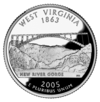 Released in 2005 |
| Butterfly | Monarch Butterfly (Danaus plexippus) |
| Reptile | Timber Rattler (Crotalus horridus) |
| Colors | Old Gold and Blue |
| Fossil | Jefferson's ground sloth (Megalonyx jeffersonii) |
| Gemstone | Silicified Mississippian Fossil Coral (Lithostrotionella) |
| Rock | Coal |
| Soil | Monongahela |
| Tartan | West Virginia Shawl |
| Fruit | Golden Delicious Apple (Malus domestica) |
Cultural
Music
Appalachian music
West Virginia's folk heritage is a part of the Appalachian folk music tradition, and includes styles of fiddling, ballad singing, and other styles that draw on Scots-Irish music. Camp Washington-Carver, a Mountain Cultural Arts Centre located at Clifftop in Fayette County, hosts an annual Appalachian String Band Festival. The Capitol Complex in Charleston hosts The Vandalia Gathering, where traditional Appalachian musicians compete in contests and play in impromptu jam sessions and evening concerts over the course of the weekend. The Augusta Heritage Centre sponsored by Davis & Elkins College in Elkins in Randolph County produces the annual Augusta Heritage Festival which includes intensive week-long workshops that are in the summer that help preserve Appalachian heritage and traditions.
Classical music
The West Virginia Symphony Orchestra was founded in 1939, as the Charleston Civic Orchestra, before becoming the Charleston Symphony Orchestra in 1943. The first conductor was William R. Wiant, followed by the conductor Antonio Modarelli, who was written about in the November 7, 1949 Time Magazine for his composition of the River Saga, a six-section program piece about the Kanawha River according to the Charleston Gazette's November 6, 1999 photo essay, "Snapshots of the 20th Century". Prior to coming to Charleston, Modarelli had conducted the Wheeling Symphony Orchestra and the Philadelphia Orchestra, according to the orchestra's website.
The Pulitzer Prize winning 20th century composer George Crumb was born in Charleston and earned his Bachelor's Degree there before moving outside the state. There had also been a series of operatic style concerts performed in Wheeling during mid-century as well.
Musical innovation
The West Virginia Cultural Center in Charleston is home to the West Virginia Division of Culture and History which helps underwrite and coordinate a large number of musical activities. The Centre is also home to Mountain Stage, an internationally broadcast live-performance music radio program established in 1983 that is carried by many affiliates of National Public Radio. The program also travels to other venues in the state such as the West Virginia University Creative Arts Centre in Morgantown.
The Center hosts concerts sponsored by the Friends of Old Time Music and Dance, which brings an assortment of acoustic roots music to West Virginians. The Centre also hosts the West Virginia Dance Festival, which features classical and modern dance.
Huntington's historic Keith-Albee Theatre, built by brothers A.B. and S.J. Hyman, was originally opened to the public on May 7, 1928, and hosts a variety of performing arts and music attractions. The theatre was eventually gifted to Marshall University and is currently going through renovation to restore it to its original splendor.
Every summer Elkins hosts the Augusta Heritage Festival, which brings folk musicians from around the world. The town of Glenville has long been home to the annual West Virginia State Folk Festival.
The Mountaineer Opera House in Milton hosts a variety of musical acts.
John Denver's song " Take Me Home, Country Roads" describes the experience of driving through West Virginia.
Symphony Sunday is an annual event hosted by the West Virginia Symphony Orchestra held in June. It is a day full day of music by community groups, food, and family fun, culminating in a free performance by the West Virginia Symphony Orchestra with a fireworks display following. The event began in 1982 and is held on the front lawn of the University of Charleston.
The Daily Mail Kanawha County Majorette and Band Festival is West Virginia's longest running music festival. It is for the eight public high schools in Kanawha County. The festival began in 1947. It is held at the University of Charleston Stadium at Laidley Field in downtown Charleston.
Sports
| Club | Sport | League |
|---|---|---|
| Marshall Thundering Herd | Football / Basketball | Conference USA |
| West Virginia Mountaineers | Football / Basketball | Big 12 Conference |
| Bluefield Blue Jays | Baseball | Appalachian League |
| Princeton Rays | Baseball | Appalachian League |
| West Virginia Power | Baseball | South Atlantic League |
| Wheeling Nailers | Ice hockey | ECHL |
| West Virginia Wild | Basketball | International Basketball League |
| West Virginia Lightning | Football | Elite Mid-Continental Football League |
| West Virginia Chaos | Soccer | USL Premier Development League |
| West Virginia Bruisers | Football | Women's Football Alliance |


